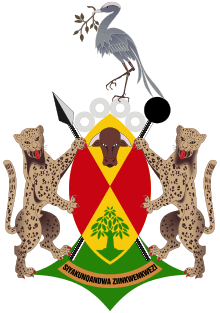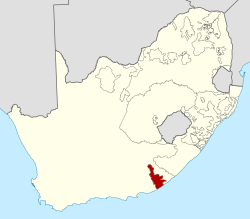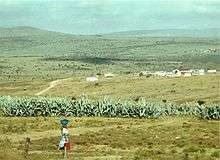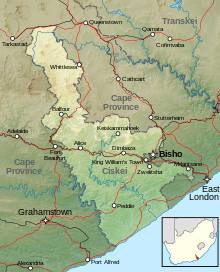Ciskei
Ciskei (/səsˈkaɪ/, /sɪsˈkaɪ/ or /sɪsˈkeɪ/) was a nominally independent state – a Bantustan – in the south east of South Africa. It covered an area of 7,700 square kilometres (3,000 sq mi), almost entirely surrounded by what was then the Cape Province, and possessed a small coastline along the shore of the Indian Ocean.
Republic of Ciskei iRiphabliki ye Ciskei | |||||||||
|---|---|---|---|---|---|---|---|---|---|
| 1981–1994 | |||||||||
 Coat of arms
| |||||||||
Motto: "Siyakunqandwa Ziinkwenkwezi" (Xhosa) "We Shall be Stopped by the Stars" or "The Sky is the Limit" | |||||||||
 Location of Ciskei (red) within South Africa (yellow). | |||||||||
| Status | Bantustan (nominal parliamentary democracy) | ||||||||
| Capital | Bisho | ||||||||
| Official languages | Xhosa[2] English[2] | ||||||||
| Chief Minister | |||||||||
• 1972–1973 | Chief J. T. Mabandla | ||||||||
• 1973–1978a | Lennox Leslie Wongamu Sebe | ||||||||
• 1978–1990b | Lennox Leslie Wongamu Sebe | ||||||||
• 1990–1994 | Brigadier General Oupa Gqozo | ||||||||
| History | |||||||||
• Self-government | 1 August 1972 | ||||||||
• Nominal independence | 4 December 1981 | ||||||||
• Re-integrated into South Africa | 27 April 1994 | ||||||||
| Area | |||||||||
| 1980[3] | 9,000 km2 (3,500 sq mi) | ||||||||
| Population | |||||||||
• 1980[3] | 677,920 | ||||||||
| Currency | South African rand | ||||||||
| |||||||||
| |||||||||
Under South Africa's policy of apartheid, land was set aside for black peoples in self-governing territories. Ciskei was designated as one of two homelands or "Bantustans" for Xhosa-speaking people.
Ngqika (Rharhabe) Xhosa people were forcibly resettled in the Ciskei, and Gcaleka Xhosa were settled in the Transkei, the other Xhosa homeland.[4][4][5] Unlike the other Bantustans, including Transkei, which saw itself as a Xhosa homeland,[6] Ciskei has been described as having "absolutely no basis in any ethnic, cultural or linguistic fact whatsoever" despite efforts by the Ciskei authorities to create a distinctive "Ciskeian" identity.[6]
In contrast to the Transkei, which was largely contiguous and deeply rural, and governed by hereditary chiefs, the area that became the Ciskei had been made up of a patchwork of "reserves"[6] interspersed with pockets of white-owned farms. There were elected headmen, it had a relatively educated working class populace[6] and there was a tendency of the region's black residents, who often worked in East London, Queenstown and King Williams Town, to oppose traditional methods of control.[7][8] These differences have been posited as the reason for two separate homelands for the Xhosa people being developed, as well as the later nominal independence of Ciskei from South Africa, than Transkei.[7]
After its creation, large numbers of blacks were expelled from designed white areas in the Cape Province by the Apartheid government to Ciskei, in particular, "non-productive Bantus"-women with dependent children, the elderly, and the infirm, and it was also treated as a reservoir of cheap black labour.[8][9] The diaspora of the Ciskei Xhosa is due to the settler colonialism and internal wars between the Xhosa.[10]
Ciskei had a succession of capitals during its existence. Originally, Zwelitsha served as the capital with the view that Alice would become the long-term national capital. However, it was Bisho (now spelled Bhisho) that became the capital until Ciskei's reintegration into South Africa.
The name Ciskei means "on this side of the Kei River", and is in contrast to the nearby Bantustan of Transkei.
History


By the time Sir John Cradock was appointed governor of the Cape Colony in 1811, the Zuurveld region had lapsed into disorder and many white farmers had begun to abandon their farms.[11] Early during 1812, on the instructions of the governor, Lieutenant-Colonel John Graham forced 20,000 Xhosa to cross the Fish River.[11] Subsequently, 27 military posts were erected across this border, which resulted in the establishment of the garrison towns of Grahamstown and Cradock.[11]
At the end of the 19th century, the area known as British Kaffraria between the Fish and Kei rivers had been set aside for the "Bantu" and was from then on known as the Ciskei.[12] Europeans gave the name Ciskei to the area to distinguish it from the Transkei, the area north of the Kei.[13]
After the Union of South Africa formed in 1910, the "Bantu" rights of occupation remained unclear and differed from colony to colony within South Africa. The Native Lands Act of 1913 demarcated the reserves in the Union, and made it illegal to sell or lease these lands to Europeans (except in the Cape Colony).[12] General Hertzog pursued his segregation policy and subsequently passed the Native Trust and Land Act in 1936.[14] This act effectively abolished the right of the Cape "Bantu" to buy land outside of the existing reserves.[14]
The boundaries of the Ciskei region changed as land was added, and excised. A notable excision was the removal of the Glen Grey and Herschel Districts, and their allocation to the newly independent Transkei,[9] with the populations of the districts moving into the rest of Ciskei to retain their South African citizenship (which was subsequently lost when Ciskei became independent).[9]
By the 1970s, the South African government decided on the final boundaries of Ciskei, as a consolidated area, through the amalgamation of existing reserves allocated to Ciskei, and the purchase of intervening white-owned land.[9] This amalgamation reduced the total length of the Ciskei's borders, making them easier for the South African government to police, as well being an attempt to create a more viable area for the homeland.[9]
Independence
In 1961 Ciskei became a separate administrative region and in 1972 was declared self-governing under the rule of Chief Justice Mabandla and then Lennox Sebe. Mabandla was a Fengu, a group that had allied itself with the British in the frontier wars, and which historically embraced colonial education and were better educated. The Rharhabe were resentful, and with the policy of "retribalisation" by the apartheid authorities, asserted their position, which culminated in the election of Sebe,[15] although Sebe later abandoned his anti-Fengu rhetoric.[16]
In 1978 it became a single-party state under the rule of Sebe, and after an independence referendum in 1980, in 1981 it became the fourth homeland to be declared independent by the South African government and its residents lost their South African citizenship. However, there were no border controls between South Africa and Ciskei.
Black people found to be living without permits in white areas or farms in South Africa, often for generations, were forcibly relocated to Ciskei by Apartheid authorities, often from "black spots" in the neighbouring "white corridor"[17] and moved into squalid resettlement camps.[18] A 1983 study by Rhodes University found that 40% of the children in one camp suffered from wasting caused by malnutrition, and 10% suffered from kwashiorkor,[17] and in another camp, at Thornhill, 50% of children died before the age of 5.[17] Typhoid epidemics also broke out in the resettlement camps, which were often isolated, and lacked health facilities, sanitation and schools, and were far from urban areas.[8] The forced relocations of blacks to the Ciskei resulted in high population densities in the homeland, a situation that persists to the present day.[9]
On several occasions, the Ciskei government imposed collective punishment on communities that opposed its rule, and people fled the Bantustan back into South Africa proper because of the harassment and denial of government services to dissenters.[19]
In common with other Bantustans its independence was not recognised by the international community. Sebe once claimed that the State of Israel had granted official recognition to Ciskei, but the Israeli Foreign Ministry denied this.[20]
Ciskei-Transkei hostilities and Operation Katzen
In 1986 and 1987,[21] Transkei, a larger, wealthier and more populous entity, undertook a series of military raids[22] on Ciskei[7][23][24] and attempted to seize control of Ciskei. One of these raids was an attack on leader Lennox Sebe's compound, with the apparent goal of taking him hostage, in order to force a merger of the two Bantustans.[25] Transkei had previously granted sanctuary to Lennox Sebe's estranged brother Charles, the former head of Ciskei's security forces, who had been imprisoned in Ciskei on charges of sedition,[17][26] and kidnapped Lennox Sebe's son[27] The South African government ostensibly intervened to warn the Transkei government off[7] however, it later emerged at the Truth and Reconciliation Commission that the plan to amalgamate the Transkei and Ciskei into a proposed Xhosaland, as well as the freeing of Charles Sebe from prison, had been carried out by South African security forces linked to the Civil Cooperation Bureau, in order to consolidate an anti-ANC front in the Eastern Cape region, as part of the abortive Operation Katzen.[28][29][30][31]
Coup d'état
In 1990 Brigadier Oupa Gqozo deposed Sebe and ruled as a dictator – despite an initial promise of a swift return to civilian rule. During 1991 and 1992 many of the legal foundations of apartheid in South Africa were removed, undermining the rationale for the homelands' continued existence. The African National Congress pressed strongly for them to be reincorporated into South Africa. This was opposed by Gqozo and the other homeland leaders.
Bisho Massacre
On 7 September 1992 the Ciskei Defence Force fired into a crowd (led by Ronnie Kasrils, Cyril Ramaphosa and Chris Hani) of ANC members demanding the removal of Gqozo.[32][33] 28 people were killed and hundreds injured in the Bisho massacre outside the sports stadium in Bisho, the small capital of Ciskei.[32][33]
| Historical states in present-day South Africa |
|---|
 |
|
before 1600
|
|
1600–1700
|
|
1700–1800
|
|
1800–1850
|
|
1850–1875
|
|
1875–1900
|
|
1900–present
|
|
|
Annexation
Gqozo refused to participate in the multiracial negotiations to agree a post-apartheid constitution for South Africa and initially threatened to boycott the first multiracial elections. This became unsustainable, and in March 1994 Ciskei government workers went on strike for fear of losing their job security and pensions in the post-apartheid era. The police then mutinied, prompting Gqozo to resign on 22 March. The Transitional Executive Council (TEC) appointed two administrators, who took control of the homeland to ensure security until the elections could be held the following month. The TEC also blocked the South African government from deploying the paramilitary Internal Stability Unit (ISU) of the South African Police force, as the unit was suspected of fomenting violence in other parts of the country, and after the Ciskei military had threatened to open fire on the ISU if it entered the territory.
Ciskei and all of the other homelands were reincorporated into South Africa on 27 April 1994, after the first post-apartheid elections. Along with Transkei, Ciskei became part of the new Eastern Cape Province, with its capital becoming the capital of the new province, and the former territory of the Ciskei forming parts of the Buffalo City Metropolitan Municipality, the Chris Hani District Municipality and the Amathole District Municipality, as of 2016.[9]
Districts in 1991
Districts of the province and population at the 1991 census.[34]
- Alice: 43,452
- Whittlesea: 50,199
- Keiskammahoek: 32,740
- Mdantsane: 105,117
- Middledrift: 37,979
- Peddie: 52,245
- Zwelitsha: 142,779
- Mpofu: 13,056
Law enforcement and Defence
- Founded in 1981 the Ciskei Defence Force consisted of two battalions and an Air-wing.
- Ciskei Police
- Ciskei Police - Law Enforcement Division
- Ciskei Prisons Service
- Ciskei Traffic Force
Notable persons
- Ngconde Balfour, former South African politician, served as Minister of Correctional Services and Minister of Sport.
- Bantu Stephen Biko, former political activist, founder and the president of Black Consciousness Movement
- Joshua Oupa Gqozo, former Ciskei's President
- Thandatha Jongilizwe Mabandla, former Ciskei's president and Ciskei's chief justice
- Membathisi Mphumzi Shepherd Mdladlana, former minister of labour, politician and ambassador in Canada
- Wilton Zimasile Mkwayi, former anti-apartheid activist and member of ANC
- Griffiths Mlungisi Mxenge, former political activist and member of ANC
- Bulelani Ngcuka, former NPA director 1999–2004
- Looksmart Khulile Ngudle, former political activist and member of ANC
- Lennox Leslie Wongamu Sebe, former Ciskei's president and long-serving President
- Xhanti Charles Sebe, former Ciskei's acting president
- Archibald 'Archie' Mncedisi Sibeko, former anti-apartheid activist and member of ANC
- Moses Twebe, former anti-apartheid activist and member of ANC
See also
- Transkei
- Fengu people
- List of heads of state of Ciskei
- Vice President of Ciskei
- Ciskei Defence Force
- Bisho massacre
Books on Ciskei
- Mager, A.K. (1999) Gender and the Making of a South African Bantustan: A Social History of the Ciskei, 1945–1959, Heinemann.
- Switzer, L. (1993) Power and Resistance in an African Society: The Ciskei Xhosa and the Making of South Africa, University of Wisconsin Press.
References
- http://www.nationalanthems.info/cis.htm
- Republic of Ciskei Constitution Act, No 20 of 1981, chapter II, section 8 "Xhosa and English shall be the official languages of the Republic of Ciskei and shall enjoy equal recognition."
- Sally Frankental; Owen Sichone (1 January 2005). South Africa's Diverse Peoples: A Reference Sourcebook. ABC-CLIO. p. 187. ISBN 978-1-57607-674-3. Archived from the original on 12 December 2013. Retrieved 18 September 2013.
- B.), Peires, J. B. (Jeffrey (2005). The house of Phalo : a history of the Xhosa people in the days of their independence. Jonathan Ball. ISBN 978-1868421596. OCLC 61529352.
- Mills, Wallace G. (August 1983). "The House of Phalo: A History of the Xhosa People in the Days of Their Independence, by J. B. PeiresThe House of Phalo: A History of the Xhosa People in the Days of Their Independence, by J. B. Peires, Berkeley, Calif., University of California Press, 1982, x, 281 pp. $27.50 (cloth), $10.75 (paperback)". Canadian Journal of History. 18 (2): 265–267. doi:10.3138/cjh.18.2.265. ISSN 0008-4107.
- "The Creation of Tribalism in Southern Africa". publishing.cdlib.org. Archived from the original on 12 August 2018. Retrieved 12 August 2018.
- "The Creation of Tribalism in Southern Africa". publishing.cdlib.org. Archived from the original on 12 August 2018. Retrieved 12 August 2018.
- "Archived copy" (PDF). Archived (PDF) from the original on 19 August 2018. Retrieved 20 August 2018.CS1 maint: archived copy as title (link)
- "Archived copy" (PDF). Archived (PDF) from the original on 11 September 2018. Retrieved 11 September 2018.CS1 maint: archived copy as title (link)
- Switzer, Les. Power and Resistance in an African Society: the Ciskei Xhosa and the Making of South Africa. University of Wisconsin Press, 1993.
- Cameron, Trewhella; Spies, S.B., eds. (1980) [1986]. An Illustrated History of South Africa (1 ed.). Jonathan Ball Publishers, Johannesburg. p. 79. ISBN 978-0-86850-118-5.
- Boyce, A.N. (1971) [1969]. Europe and South Africa: A history for South African High Schools (3 ed.). Juta & Company, Limited. p. 700.
- Bulpin, T.V. (1980). Mayhew, Vic; Duncan, Tony; Handler, Rosemund (eds.). Illustrated Guide to Southern Africa (2 ed.). Reader's Digest. p. 152. ISBN 978-0-620-04650-3.
- Boyce, A.N. (1971) [1969]. Europe and South Africa: A history for South African High Schools (3 ed.). Juta & Company, Limited. p. 702.
- "The Creation of Tribalism in Southern Africa". publishing.cdlib.org. Archived from the original on 12 August 2018. Retrieved 12 August 2018.
- "The Creation of Tribalism in Southern Africa". publishing.cdlib.org. Archived from the original on 12 August 2018. Retrieved 12 August 2018.
- Lelyveld, Joseph. "MISERY IN A SOUTH AFRICAN 'HOMELAND'". Archived from the original on 5 February 2018. Retrieved 12 August 2018.
- "The Creation of Tribalism in Southern Africa". publishing.cdlib.org. Archived from the original on 12 August 2018. Retrieved 12 August 2018.
- "Truth Commission - Special Report - TRC Final Report - Volume 2, Section 1, Chapter". sabctrc.saha.org.za. Archived from the original on 18 August 2018. Retrieved 18 August 2018.
- Sasha Polakow-Suransky, The Unspoken Alliance: Israel's Secret Relationship with Apartheid South Africa, (New York: Pantheon Books), 2010, p. 157.
- "Truth Commission - Special Report - TRC Final Report - Volume 2, Section 1, Chapter 5, Subsection 22". sabctrc.saha.org.za. Archived from the original on 9 September 2018. Retrieved 9 September 2018.
- "Truth Commission - Special Report - TRC Final Report - Volume 2, Section 1, Chapter 5, Subsection 21". sabctrc.saha.org.za. Archived from the original on 9 September 2018. Retrieved 9 September 2018.
- "The Creation of Tribalism in Southern Africa". publishing.cdlib.org. Archived from the original on 12 August 2018. Retrieved 12 August 2018.
- Times, Alan Cowell and Special To the New York. "PRETORIA PUZZLE: 'HOMELANDS' AT ODDS". Archived from the original on 19 August 2018. Retrieved 19 August 2018.
- "2 SOUTH AFRICAN 'HOMELANDS' DO BATTLE". 20 February 1987. Archived from the original on 12 August 2018. Retrieved 12 August 2018 – via www.washingtonpost.com.
- "Former commander of the armed forces of the Ciskei, Major-General Charles Sebe is imprisoned". South African History Online. 16 March 2011. Archived from the original on 18 August 2018. Retrieved 18 August 2018.
- PARKS, MICHAEL (27 September 1986). "Commandos Storm S. Africa Homeland, Free Coup Leader, Seize President's Son". Archived from the original on 19 August 2018. Retrieved 19 August 2018 – via LA Times.
- "AMNESTY APPLICATION OF FORMER TOP EASTERN CAPE SECURITY POLICEMAN". www.justice.gov.za. SAPA. Archived from the original on 3 March 2011. Retrieved 7 September 2018.
- "INTELLIGENCE CHIEF SPEAKS OUT ON OPERATION KATZEN". www.justice.gov.za. SAPA. Archived from the original on 3 March 2011. Retrieved 7 September 2018.
- "Truth Commission - Special Report - TRC Final Report - Volume 6, Section 3, Chapter 1, Subsection 26". sabctrc.saha.org.za. Archived from the original on 9 September 2018. Retrieved 9 September 2018.
- "Truth Commission - Special Report - Glossary: Operation Katzen". sabctrc.saha.org.za. Archived from the original on 9 September 2018. Retrieved 9 September 2018.
- Ronnie Kasrils (7 May 2004). "A Decade of Democracy: What if Boipatong and Bisho had not happened?". FinancialMail.co.za. Archived from the original on 21 April 2013. Retrieved 22 December 2010.
- "Evidence that Ciskei massacre was planned". GreenLeft. 30 September 1992. Archived from the original on 25 October 2010. Retrieved 22 December 2010.
- "Census > 1991 > Ciskei > Variable Description > ... > District code". Statistics South Africa - Nesstar WebView. Archived from the original on 19 June 2016. Retrieved 18 August 2013.
External links
| Look up Ciskei in Wiktionary, the free dictionary. |
| Wikimedia Commons has media related to Ciskei. |
